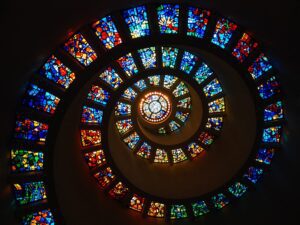Chinese-Japanese-Asian
This section explains the various ways the Beatific Vision has been shown, depicted and described across the centuries among the Asian cultures and religions.
What’s interesting about this section or at least how I’ll start it out, is that even though the previous two religions had much syncretism, and even though that syncretism did occur in China, the Chinese still seem to have retained their own particular set of myths and ideas along with how to discuss and or depict the mystical experience of the attainment of wisdom or immortality, separate from Buddhist influence.
No better place to start in showing the mystical experience and that which is see than with the legendary Fu-Shi from around 3000 BC. As his name implies when translated, he’s the bright one that discovered the trigrams: rings, characters, letters, magic symbols, they’ve been interpreted in many ways. Not my job to say one or the other. The important thing is to state and show where it is said that he discovered these magical symbols or rings. On the back of a tortoise. And if you look at the picture in the gallery of the tortoise shell since I know not everybody has a hulking desert sulcata tortoise stomping around in their backyard the way I do. What image or pattern do you see on the back of the tortoise? The ring within the ring symbol of the mystical, Beatific Vision.
Again, somebody allegorizing this or one that hasn’t had an actual mystical experience and thinks this weird or primitive or silly, might not think to literally look at the back of a tortoise to see if they’d also have an experience where magical symbols and rings began to appear. Incredible is all I can say that after five thousand years the knowledge and memory of this mystical experience still remains with us. That archaeologists have found tortoise shells from this time-period in China with symbols written on them as divinatory fortunes says that there was validity to this idea of mystical or magical power of telling the future on the back of tortoises, since by that point they were probably already doing this practice in a superstitious manner instead of what the actual knowledge that Fu-Shi would have imparted to the people was. Though, since this story has remained throughout the ages, the actual knowledge was probably kept with the sages of China over the centuries.
And if scholars haven’t fully understood why these fortunes were written on tortoise shells, hopefully this website and said author sheds light on the reason why: because it symbolizes what is seen in the mystical experience and what Fu-Shi saw in his mystical experience . . . if there was an actual Fu-Shi and that this wasn’t simply a story, then either this person was meditating while staring at the back of a tortoise shell and began to have the mystical vision and was seeing eternity and symbolic language emerging out of it by doing this, or was meditating, saw eternity and the nature of symbolic language emerging out of the silence and darkness of the mind, or the blessing from heaven that came with the experience, and then matched what was seen in the mystical vision with what is seen on the back of the tortoise and made it the symbol and receptacle for the experience as a method of divinizing. Either way, the same pattern of what is seen during the mystical experience. . .


